Photos
Harry Gottesman and friends
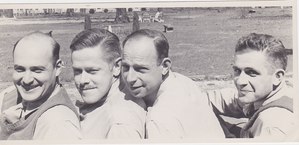
Not so good of Milburn
" " " " Phil
" too " " Hap
Me - I'm fat!!


Not so good of Milburn
" " " " Phil
" too " " Hap
Me - I'm fat!!

Phil was in the throws of the dts when he took this. We were sober of course. HG center.

Habay la Vielle, Belgium. HG on right.
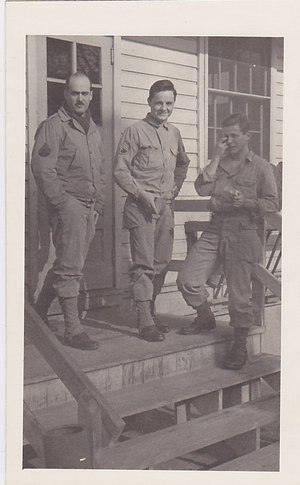
At Ft. Meade. HG at left


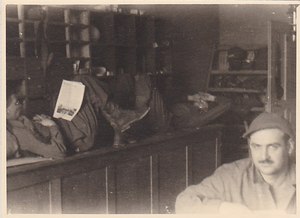
Me and Jim Moore and Tim. HG at right
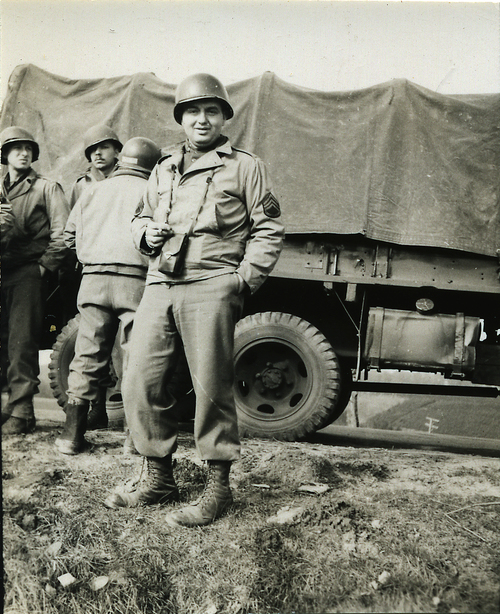
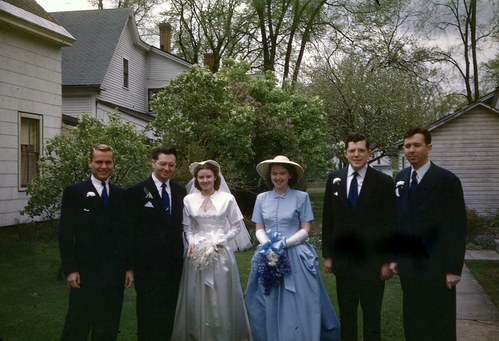
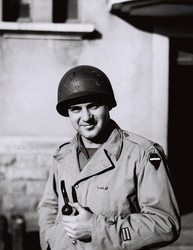
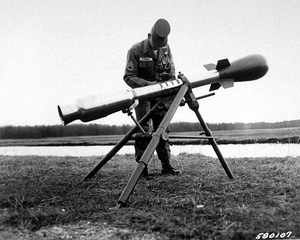
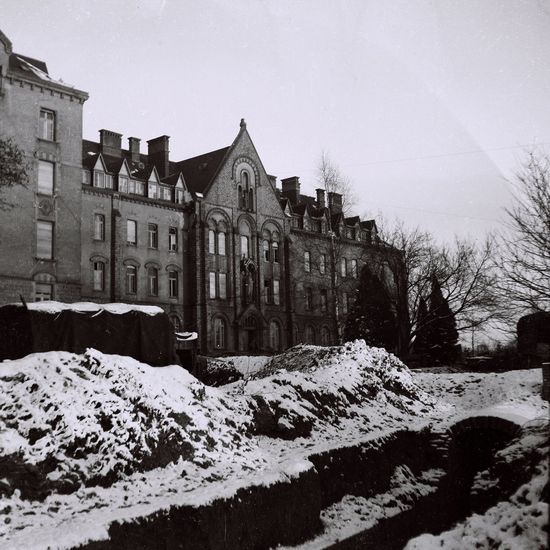
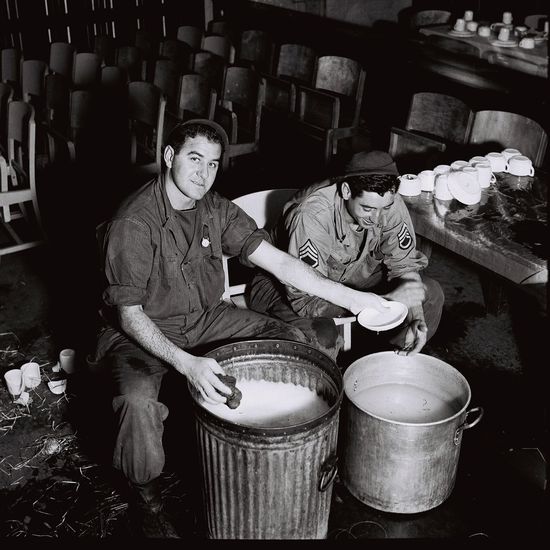
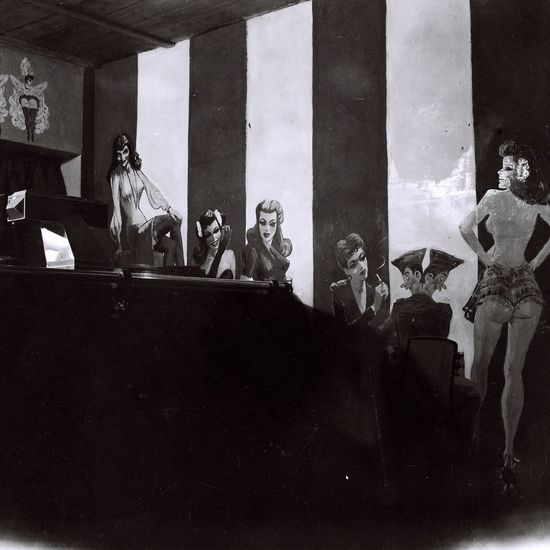
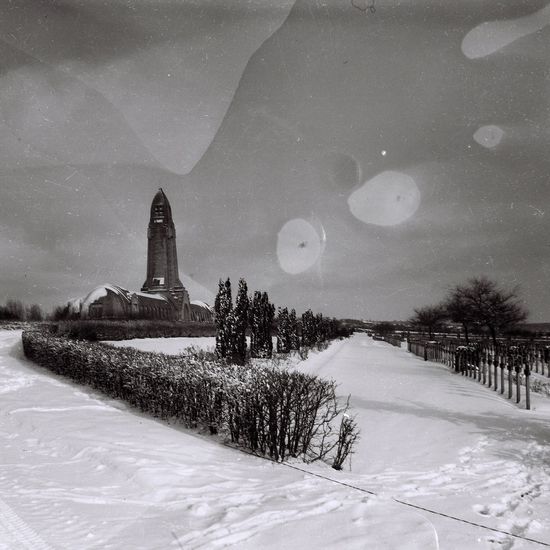
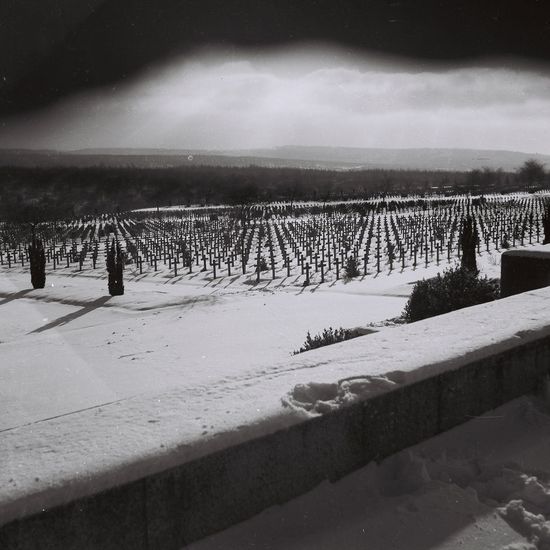
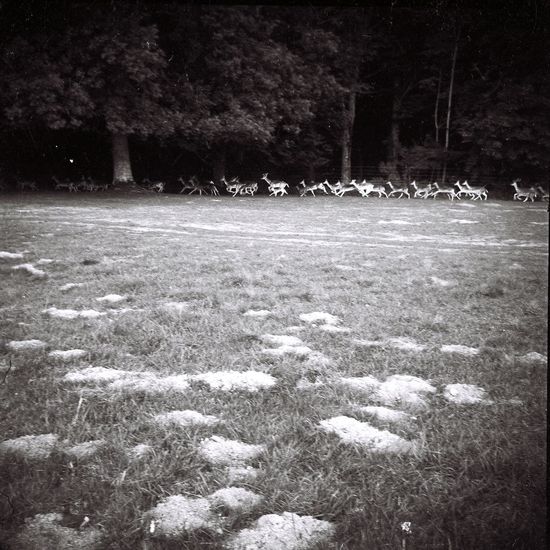
* * *
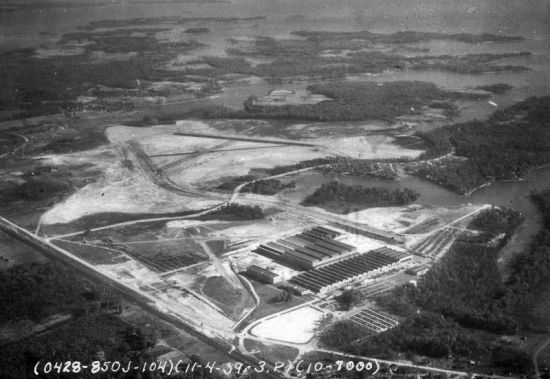
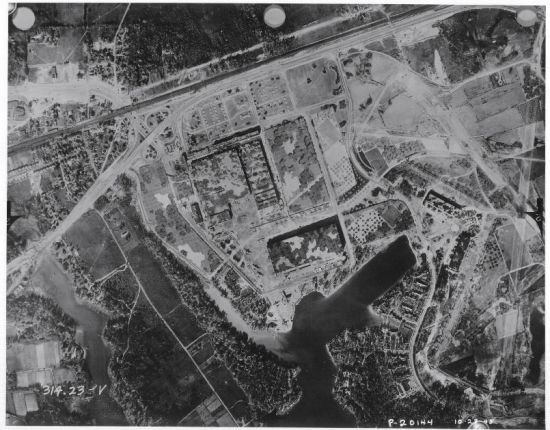
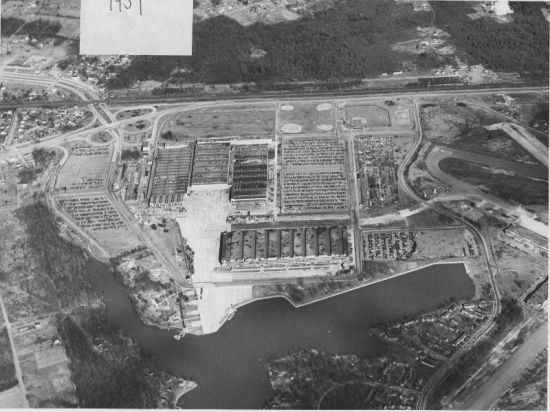
* * *
Once the disguise was complete, it was time for the 603rd to take their talents on the road. In January of 1944, the 603rd joined a handful of other specially picked units to form the 23rd Special Troops, otherwise known as the Ghost Army. Their mission fundamentally changed from hiding things on the American coastline to making things appear on the European front line.
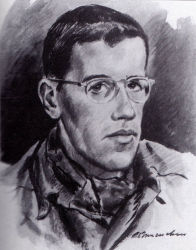
Courtsy of Don Fox
The attitude of the 23rd HQs towards their mission is lopsided. There is too much MILITARY and not enough SHOWMANSHIP.
Like it or not, the 23rd HQ must consider itself a traveling road show ready at a moment’s notice to present:
THE SECOND ARMORED DIVISION—by Brooks
THE NINTH INFANTRY DVISION— by Eddy
THE SEVENTH CORPS— by Collins
The presentations must be done with the greatest accuracy and attention to detail. They will include the proper scenery, props, costumes, principals, extras, dialogue, and sound effects. We must remember that we are playing to a very critical and attentive radio, ground, and aerial audience. They must all be convinced.
Fred Fox said: Why don’t we put a stencil of the name of the unit that we were simulating, right on the trucks? And why don’t we start a counterfeit shoulder patch factory, where they would see we’re with the 75th Division (one of the divisions we did). And so forth. And the brass, were against it. But after Fox had been haranguing them for, I think, several weeks, they went along markers, things of that kind.
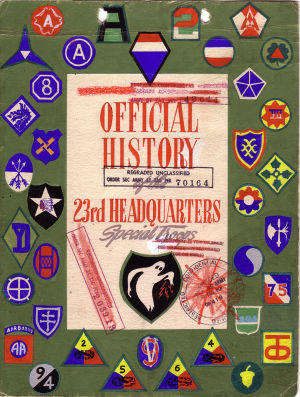
“Officers who had once commanded 32-ton tanks, felt frustrated and helpless with a battalion of rubber M-4s, 93 pounds fully inflated. The adjustment from man of action to man of wile was most difficult. Few realized at first that one could spend just as much energy pretending to flight as actually fighting.”
“By clever manipulation, the 23rd was able to garner 520 cases of cognac. This was enough liquid to drive one jeep 22,000 miles if Cognac would explode. And don’t think it wouldn’t. So this bivouac area is referred to as "Cognac Hill."
Verdun is a depressing city filled with a million ghosts of other unhappy soldiers. That makes it much too crowded... It is hard to celebrate in dreary, cold, unlighted barracks, especially when neither liquor, victory, home nor girls are available.
On 30 August, Army Ground Forces wrote SECOND ARMY that the 23rd was to be deactivated by 15 September. Its ashes were to be placed in a small Ming urn and eventually tossed into the China Sea.On 10 September the 23rd Adjutant told your 87-pointed historian that the only thing that kept him from being released was the completion of this story. So now it’s done and tomorrow I will be a free man again.
The End
Frederick E. Fox
01-634769
Capt AUS Sig O. ret.
“Officers who had once commanded 32-ton tanks, felt frustrated and helpless with a battalion of rubber M-4s, 93 pounds fully inflated. The adjustment from man of action to man of wile was most difficult. Few realized at first that one could spend just as much energy pretending to flight as actually fighting.”
--Official U.S. Army History of the 23rd Headquarters Special Troops, written by Capt. Fred Fox
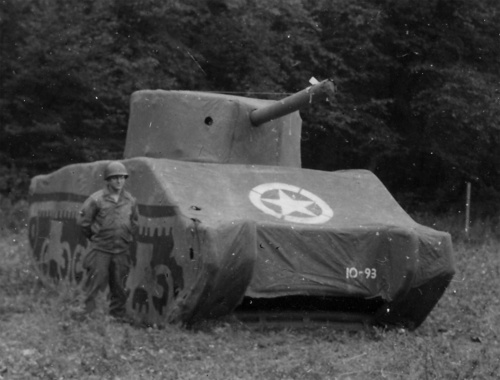
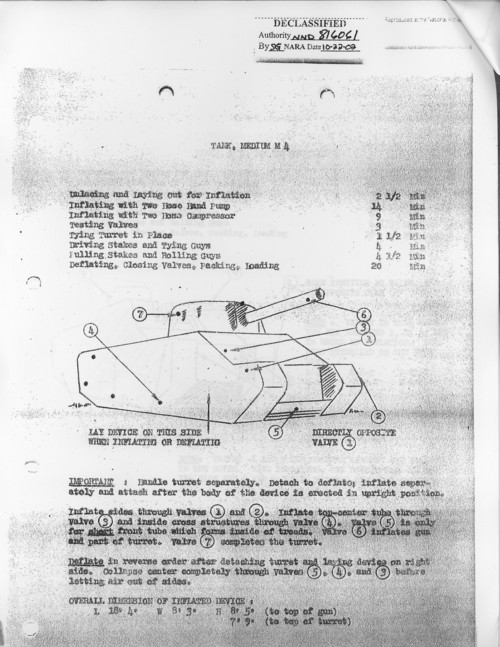
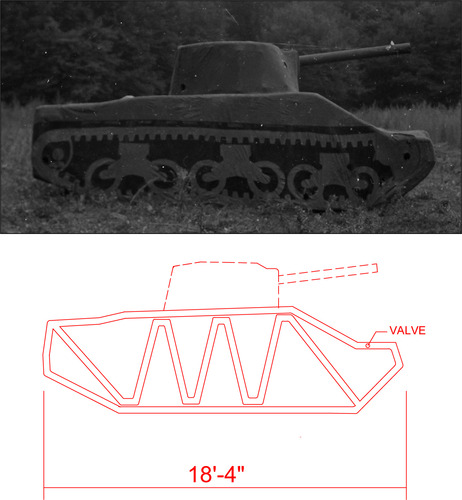
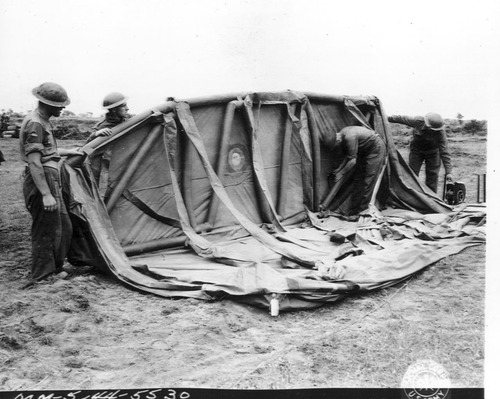
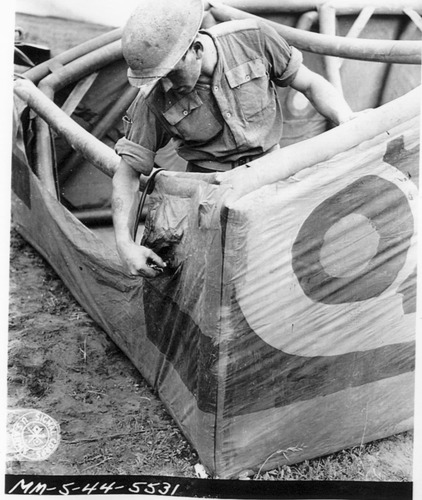
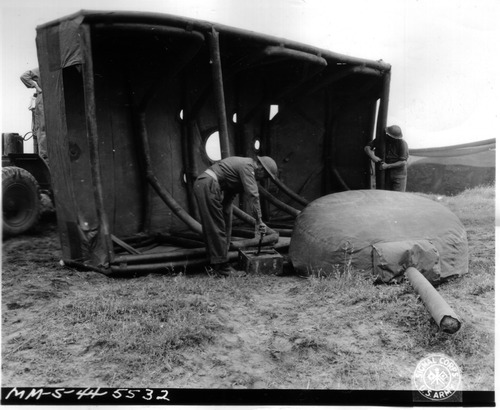
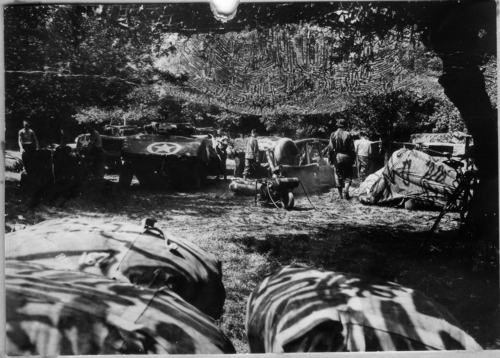
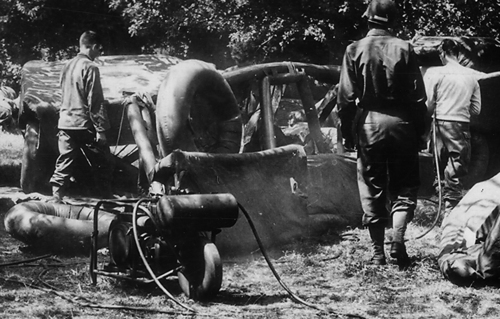
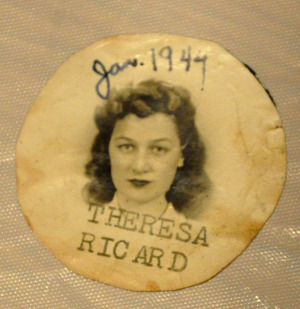
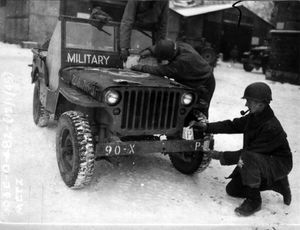


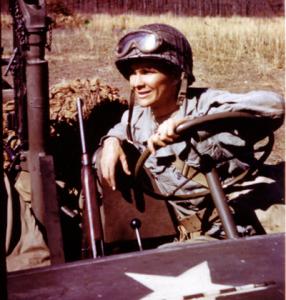
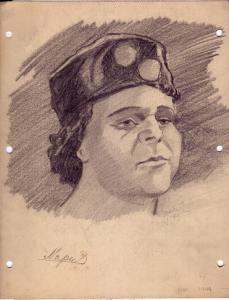 In Luxembourg, and later in Trier, Germany, the men of the Ghost Army came across many Russian refugees whom the Germans had imprisoned or enslaved. In the parlance of the time they were known as "Displaced Persons." Some of the most moving portaits painted by artists in the unit are of those refugees, may of whom are believed to have been executed or sent to the Gulag once they were repatriated to the Soviet Union. This is a woman who Jarvie knew only as "Mama."
In Luxembourg, and later in Trier, Germany, the men of the Ghost Army came across many Russian refugees whom the Germans had imprisoned or enslaved. In the parlance of the time they were known as "Displaced Persons." Some of the most moving portaits painted by artists in the unit are of those refugees, may of whom are believed to have been executed or sent to the Gulag once they were repatriated to the Soviet Union. This is a woman who Jarvie knew only as "Mama."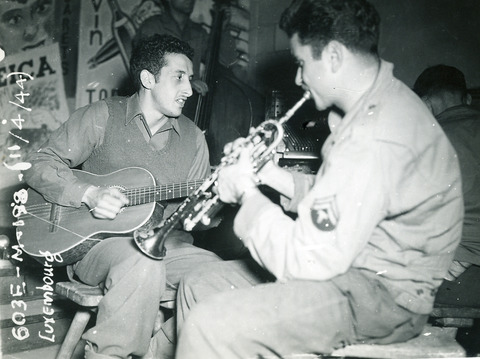
No shortage of talent among these men
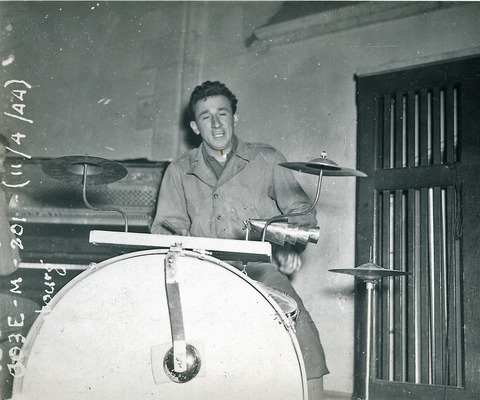
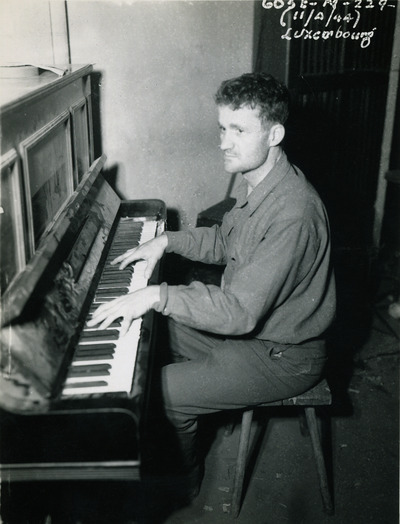
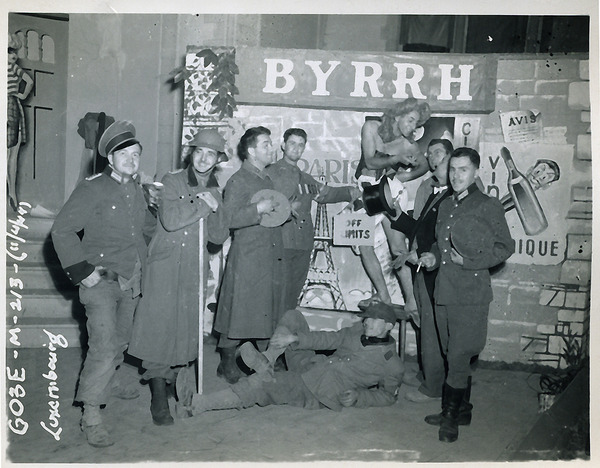
"These images were posted by Keith McKane, whose father Mickey was in the 603rd Camouflage Engineers. The markings on the photos suggest they were taken by George Martin, who was the official photographer of the unit. The pictures were all taken on November 4, 1944, when the unit was in Luxembourg. The backdrop in the bottom photo was part of the "Blarney Theater" that the men set up in the semininaryin Luxembourg where many of them were billeted. This was the same stage on which Marlene Dietrich sang to them. More on that in another entry!"
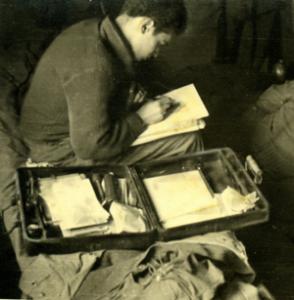
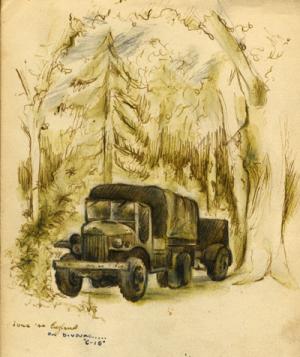 Harris was an assistant truck driver in the Ghost Army, and recalls that he grew "very fond" of his two-and-a-half ton truck (known in the Army as a "deuce and a half"). The driver of the truck was George Diestel, who later became an actor and set designer in Hollywood.
Harris was an assistant truck driver in the Ghost Army, and recalls that he grew "very fond" of his two-and-a-half ton truck (known in the Army as a "deuce and a half"). The driver of the truck was George Diestel, who later became an actor and set designer in Hollywood. 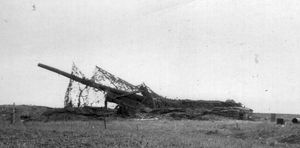
Dummy artillery emplacement
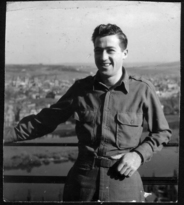
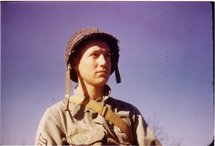


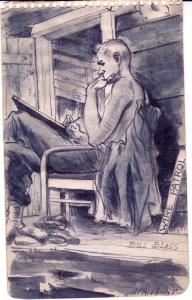
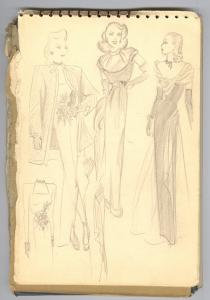

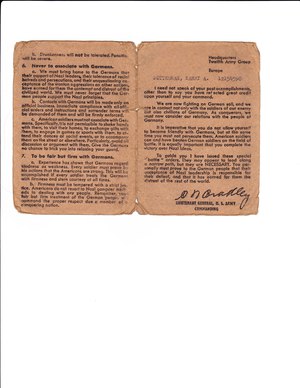
Special orders for interacting with Germans.
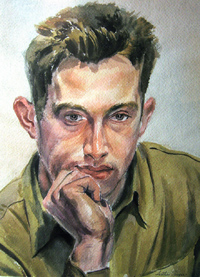
A wartime self portrait.
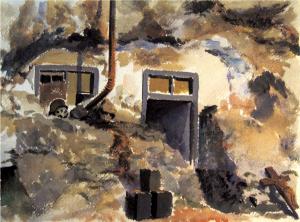 "It reeked of World War I," recalls Bob Conrad, from the Signal Company Special. Singer painted this haunting scene of an abandonded French fort there. At least one other Ghost Army artist, Ned Harris, sketched the same scene.
"It reeked of World War I," recalls Bob Conrad, from the Signal Company Special. Singer painted this haunting scene of an abandonded French fort there. At least one other Ghost Army artist, Ned Harris, sketched the same scene.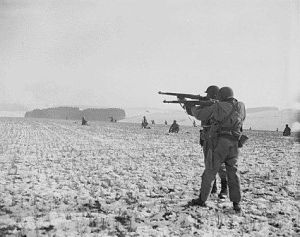
American troops fighting in the Ardennes. Photo Courtesy of the National Archives.
"I left Luxembourg [City] morning of Dec. by jeep with Lt. Andrews and our equipment. Drove via Arlon to Bastogne (12th Army Group planning) for instructions. We got our orders plus billeting for the night at a house further back on the main road.Had a big feather bed on the 2nd floor (cold, bed warmed with long handled charcoal warmer.) Had coffee, bread, and hot oatmeal with hot milk for breakfast. (mmm) Drove secondary roads heading through Wiltz, east to Hoscheid to parish house, met village priest who arranged billet and bivouac area for C Company, 603rd Engineers due to arrive for the operation the next day. (The priest) billeted the lieutenant and I in the parish house where a bishop’s portrait hung over the headboard. “This is the bishop’s bed,” he announced reverently, “you’ll sleep here tonight – he won’t be here - Sunday.” Next day mass was interesting – no pews, just high back-wood spoke canewoven low seats that could be turned around for kneeling. Many of the company attended...before getting into their various simulations, to attract more German strength to counter that of our simulated division. I’m certain other units of the 23rd were doing simulations in various other areas (we were rarely all together.) However, shortly we were alerted to massive Nazi offensives threatening right into our front.We pulled out immediately with approximately 100 men and secret equipment in the face of a vicious two division armored attack. We were pulled back into Luxembourg City and installed into defensive position – any capture of part of our unit or equipment would’ve exposed the US deception so we were quickly moved to Verdun. Hoscheid was an immediate crossroad target in from of Wiltz and Bastogne for the 5th Panzer Army."
-John Jarvie, 603rd Camouflage Engineers
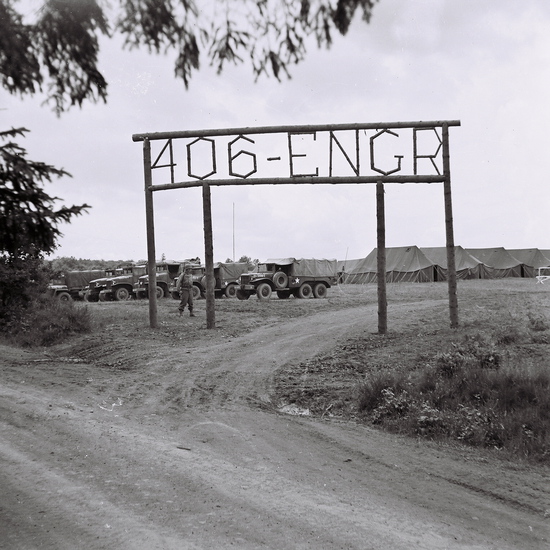
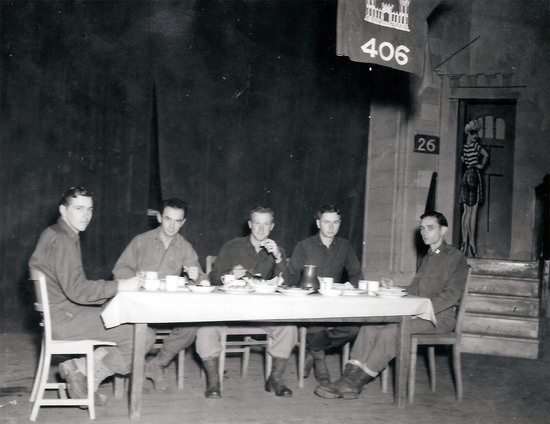
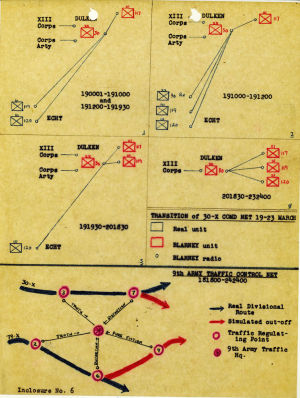
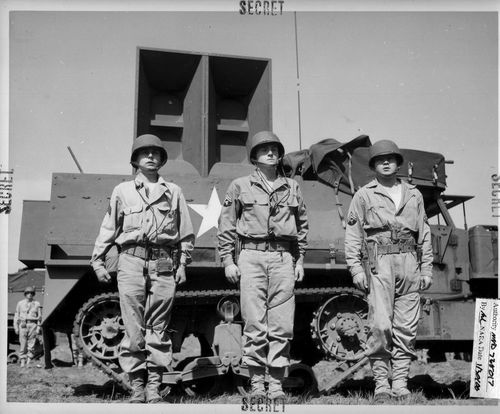
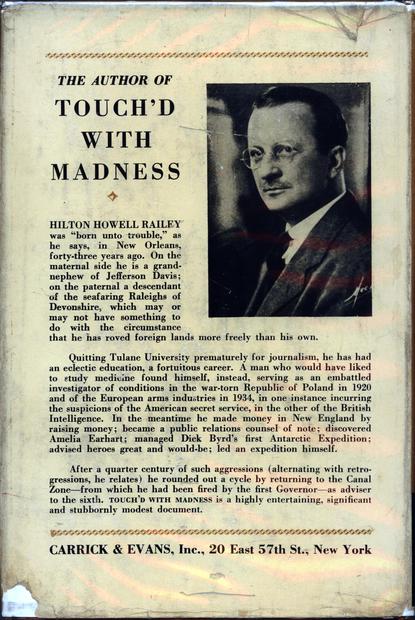
We could go in at night and crank the speakers up out of the back of the half-track, and play a program to the enemy all night, of us bringing equipment into the scene. And we could make them believe that we were coming in with an armored division.
-Lt. John Walker, 3132 Signal Company
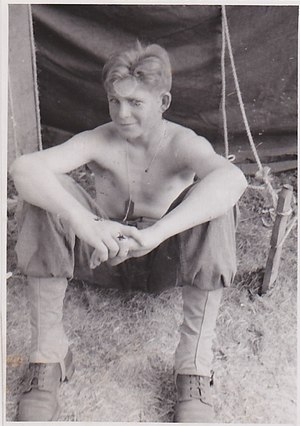
Henry Lane Eng 44
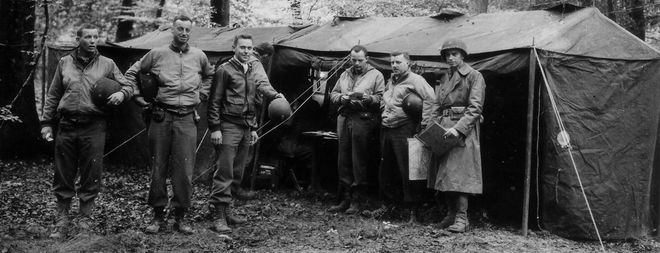
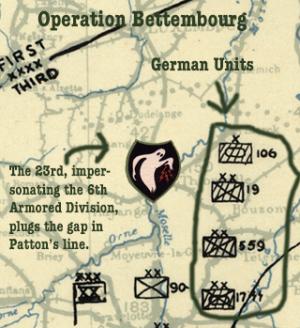 One of the riskiest deceptions the 23rd engaged in was Operation BETTEMBOURG, in September of 1944. After racing across France, George Pattons Third Army was stalled near the Moselle River. When Patton massed troops for an attack on the fortified city of Metz, it left a dangerous 70-mile gap in the northern part of the Third Army's front line. A German counterattack through that hole could cripple Pattons flank. The 23rd was called on to ride to the rescue. Its ambitious mission: plug the hole in the line by pretending to be the 20 thousand men of the 6th Armored Division.
One of the riskiest deceptions the 23rd engaged in was Operation BETTEMBOURG, in September of 1944. After racing across France, George Pattons Third Army was stalled near the Moselle River. When Patton massed troops for an attack on the fortified city of Metz, it left a dangerous 70-mile gap in the northern part of the Third Army's front line. A German counterattack through that hole could cripple Pattons flank. The 23rd was called on to ride to the rescue. Its ambitious mission: plug the hole in the line by pretending to be the 20 thousand men of the 6th Armored Division. 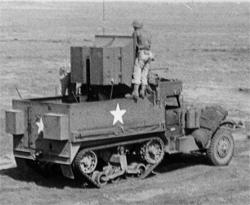 ( A more detailed account of Operation Bettembourg can be found here.)
( A more detailed account of Operation Bettembourg can be found here.) 
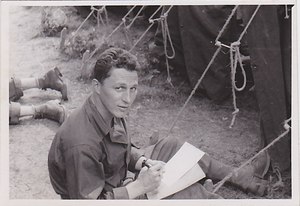
Latini Eng 44
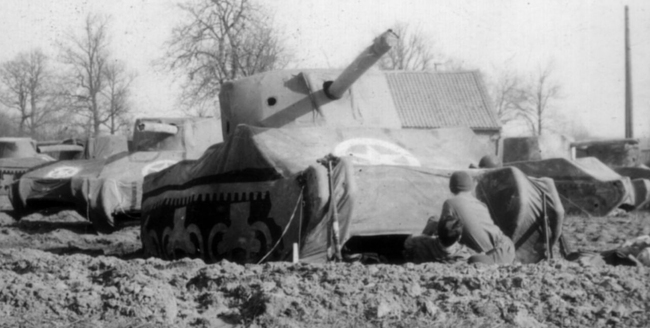
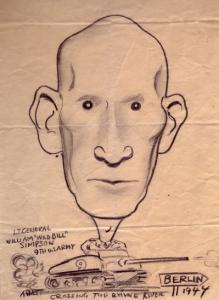 The result was extremely successful. Intelligence reported German units converging across the river from the deception. When the two divisions being impersonated by the 23rd attacked miles up the Rhine, they met only disorganized resistance and suffered an astonishingly low number of casualties. Ninth Army commander William Simpson issued the 23rd a commendation: The careful planning, minute attention to detail, and diligent execution of the tasks to be accomplished by the personnel of the organization reflect great credit on this unit.
The result was extremely successful. Intelligence reported German units converging across the river from the deception. When the two divisions being impersonated by the 23rd attacked miles up the Rhine, they met only disorganized resistance and suffered an astonishingly low number of casualties. Ninth Army commander William Simpson issued the 23rd a commendation: The careful planning, minute attention to detail, and diligent execution of the tasks to be accomplished by the personnel of the organization reflect great credit on this unit.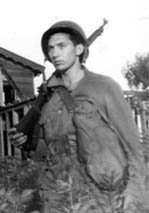
 This is one of a number of sketches Bill made during the war. Bill was interviewed for the film in New York City on July 19, 2006.
This is one of a number of sketches Bill made during the war. Bill was interviewed for the film in New York City on July 19, 2006.
Reinwald
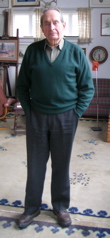
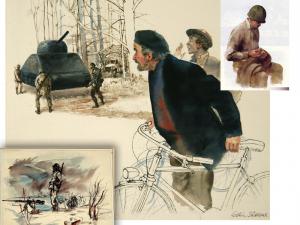 The painting in the center of the montage at right was made after the war , and depicts a true incident where two French civilians came upon the Ghost Army and thought they saw four Americans lifting up a tank. Arthur was interviewed for the film at his home on July 20, 2006.
The painting in the center of the montage at right was made after the war , and depicts a true incident where two French civilians came upon the Ghost Army and thought they saw four Americans lifting up a tank. Arthur was interviewed for the film at his home on July 20, 2006.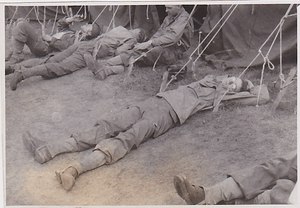
Willy Flemer

Hal Laynor during WW II
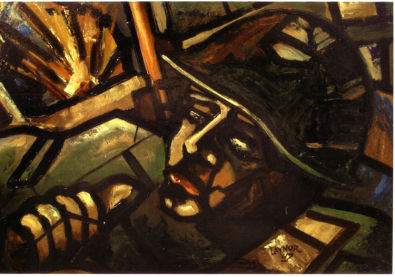
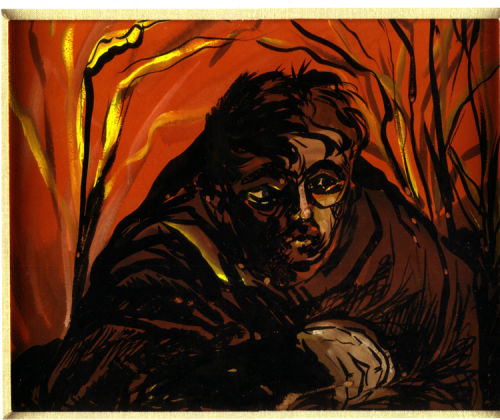

Table of Organization (pdf)This Table of Organization (TOO in military parlance) is a diagram that shows the structure of the unit, and what all the sub-units were.
Headquarters Company Roster (pdf)This roster was put together for the trip home across the Atlantic on the General O.H. Ernst. in June, 1945.
603rd Camouflage Engineers (pdf)An undated roster of the 603rd.
3132 Signal Company, Special (pdf)This is a list of men in the 3132 listed in a caption from a group photo taken before they left for Europe. Thus the men are not listed either alphabetically, or by platoon.
Signal Company, Special Roster (pdf)This roster of the Signal Company, Special (Formerly the 244th Signal Company) was put together for the trip home across the Atlantic on the General O.H. Ernst.
406th Combat Engineers (pdf)This is the April, 1944 order that creates the 406th Combat Engineers in April 1944. It essentially takes all the men in the 293 Combat Engineers and moves them into this new unit as part of the 23rd.
New York Leave List (pdf)This is an August, 1945 list of N.Y. men from the 23rd authorized to go on leave. It comes from the collection of John Jarvie. It may contain names that didn't get on the other lists.
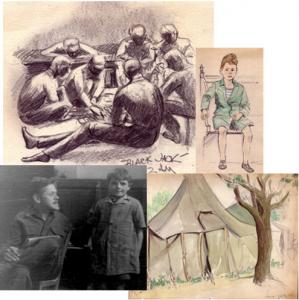
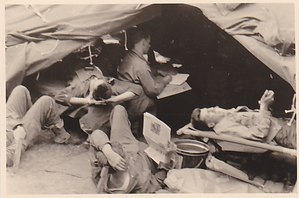
Group resting
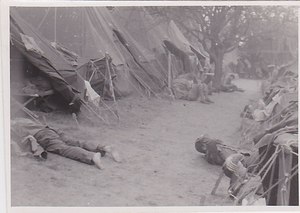
Boccia at left
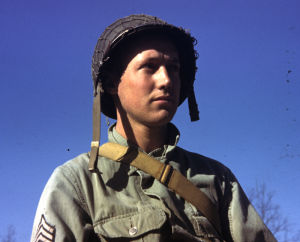
Photo by Bob Boyajian
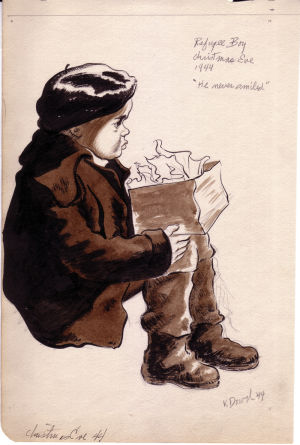
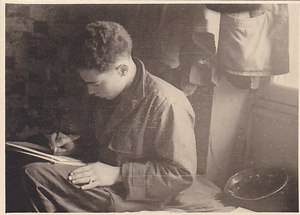
Ned Harris sketching

Sketch by George Vander Sluis
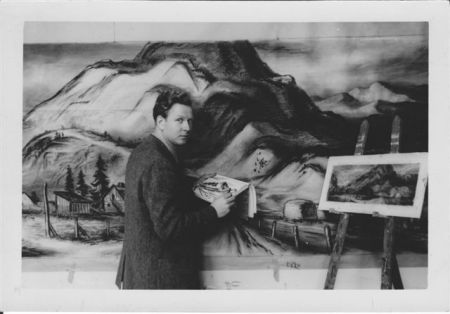
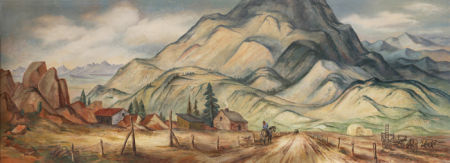
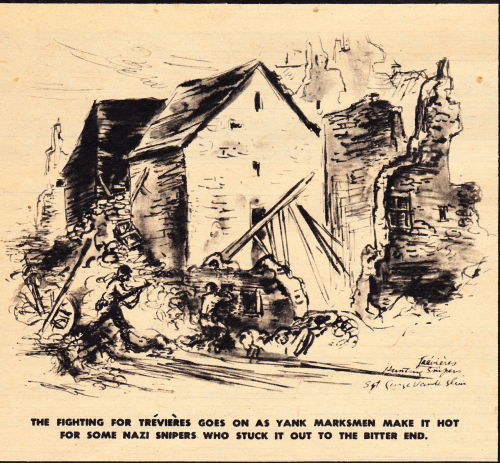
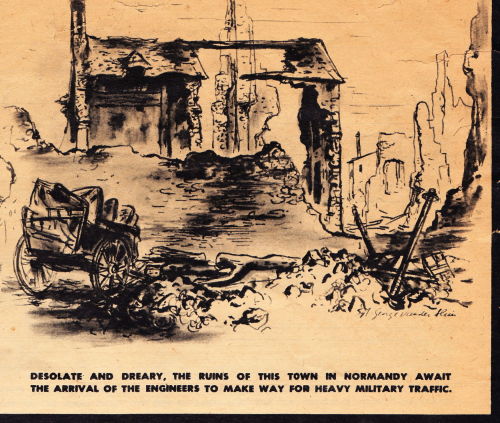
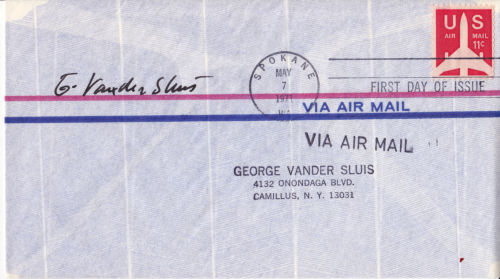
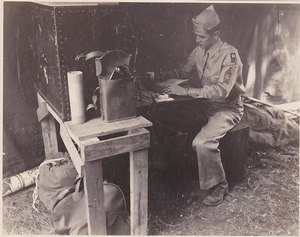
Nothing written on back. Communications setup?
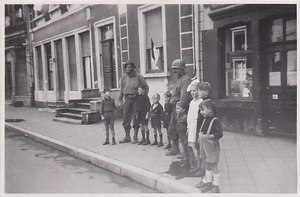
With kids in Europe
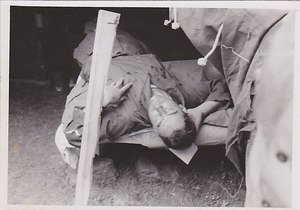
Wm Lane
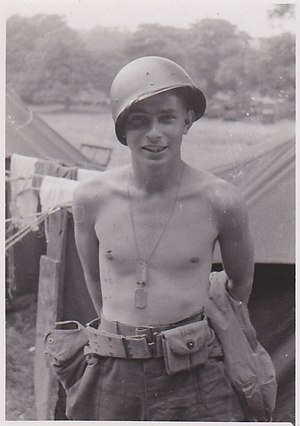
Geo Harvey
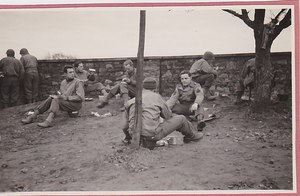
Chow at the Seminary